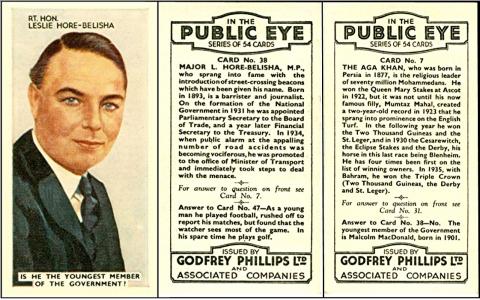
The subject of our card is Baron [Leslie] Hore Belisha who attempted to modernise the entire British transport network during his tenure as Minister for Transport.
And he has a lasting memorial on our roads, which we will show you tomorrow.
He was born Isaac Leslie Belisha in Hampstead, on September the 7th 1893 - the "Hore" prefix was added to the family name when his mother married the Secretary of the Ministry of Pensions, Adair Hore, his birth father having died when our man was less than a year old.
He was intrigued by this world of law and legalities, and trained to become a barrister, however he also had a flair for politics, and stood for the Liberal Party in Plymouth-Devonport in 1922. He did not win that year, but he did win at the General Election which was held the following year. Then, after the 1931 General Election he found himself appointed as a junior minister at the Board of Trade, becoming Financial Secretary to the Treasury the following year.
In 1934 he took over as Minister For Transport. This post had first been created in 1919, and the first holder of office was the Conservative Eric Campbell Geddes, who had been heavily involved with railways and risen to the rank of Major General in the First World War in the Military Transportation Section, on the Western Front. Personal ownership of cars was rare then, and under a thousand cars were registered as being on the roads, but by 1920 there were getting on for 200,000 private vehicles jostling for space. This was an even greater amount by 1930, when, for some reason, it was decided that the speed limit no longer applied. The reason for this, shockingly, was that most people ignored it, and the backlog of people waiting to come to court was just way too many to handle. Indeed, if you were a member of the Automobile Association, or the Royal Automobile Club, you were entitled to have them defend you in a court of law against any speeding offense.
Anyway, and unsurprisingly, within a few years of the removal of the speed limit the injuries and deaths caused by vehicles, and to their drivers and passengers, was becoming very alarming. In the year that our man took over, there would be some 7,343 deaths and 231,603 injuries recorded, half of these being to pedestrians.
One of his first jobs was to re-write the rules, and restore a speed limit within built up areas of 30 mph. This was ten miles an hour higher than it had been when it was removed four years earlier, but opposition was strong. He also rewrote the rules of the road for drivers, known as The Highway Code, first published in 1931. Most importantly he created the Driving Test, in March 1935. At first this was on a voluntary basis - and the first pass certificate was awarded on the 16th of March - but on June the 1st, 1935, it became something that you had to pass in order to drive a car.
The cards from this set are not always in great condition, because they were glazed, which suffers badly with rough handling, even a tiny bend can make a crack right across the card, and also they were adhesive backed.
They are interesting though, and there was also a cunning ploy to ensure you collected the whole set, because each front poses a question at the bottom - in this case "Is he the youngest member of the Government ?" However when you go down to the bottom of the reverse it says "As a young man he played football, rushed off to report his matches, but found that the watcher sees most of the game. In his spare time he plays golf." Some of the collectors, those who read things carefully and did not skip right to the end would not have read this, they would have seen instead that right above this seemingly odd statement was another line "For answer to question on front, see Card No. 7". Number seven is the Aga Khan, and the bottom of his reverse says "No. The youngest member of the Government is Malcolm MacDonald, born in 1901". To save you wondering, no, they did not get this wrong, because there was a Malcolm John MacDonald, and he was Ramsay MacDonald`s son, plus also a Labour M.P. and later the Governor of Kenya.
Whilst the person who rushed off after playing football turns out to be George Allison, director of Arsenal F.C. and also a sports commentator.
This revised photo shows the front and back of this card, plus the answer to the question on that other card.
There is one card in the set which suffered badly from errors, this shows the cricketer Nichols, who was at first given an unwarranted second “L”. His card was also updated in 1935, with words added “..and in 1935, 1249 runs and 157 wickets”, and I wonder if this was not when the error was discovered.
